小学六年级英语介词用法及练习
- 格式:pdf
- 大小:3.98 MB
- 文档页数:12
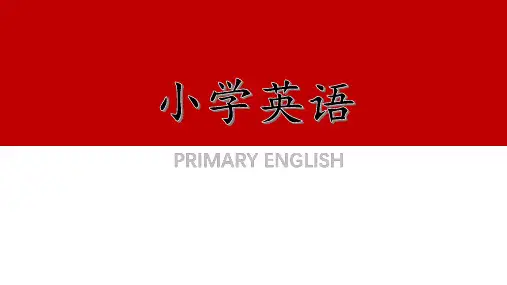

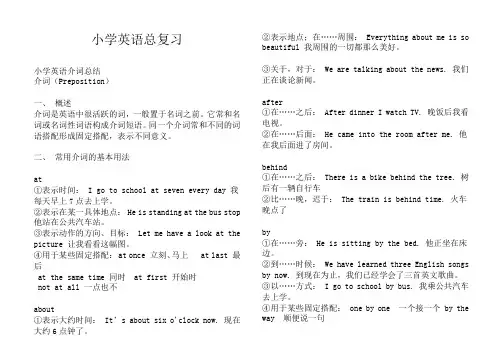
小学英语总复习小学英语介词总结介词(Preposition)一、概述介词是英语中很活跃的词,一般置于名词之前。
它常和名词或名词性词语构成介词短语。
同一个介词常和不同的词语搭配形成固定搭配,表示不同意义。
二、常用介词的基本用法at①表示时间: I go to school at seven every day 我每天早上7点去上学。
②表示在某一具体地点: He is standing at the bus stop 他站在公共汽车站。
③表示动作的方向、目标: Let me have a look at the picture 让我看看这幅图。
④用于某些固定搭配: at once 立刻、马上 at last 最后at the same time 同时 at first 开始时not at all 一点也不about ①表示大约时间:It’s about six o'clock now. 现在大约6点钟了。
②表示地点;在……周围: Everything about me is so beautiful 我周围的一切都那么美好。
③关于,对于: We are talking about the news. 我们正在谈论新闻。
after①在……之后: After dinner I watch TV. 晚饭后我看电视。
②在……后面: He came into the room after me. 他在我后面进了房间。
behind①在……之后: There is a bike behind the tree. 树后有一辆自行车②比……晚,迟于: The train is behind time. 火车晚点了by①在……旁: He is sitting by the bed. 他正坐在床边。
②到……时候: We have learned three English songs by now. 到现在为止,我们已经学会了三首英文歌曲。
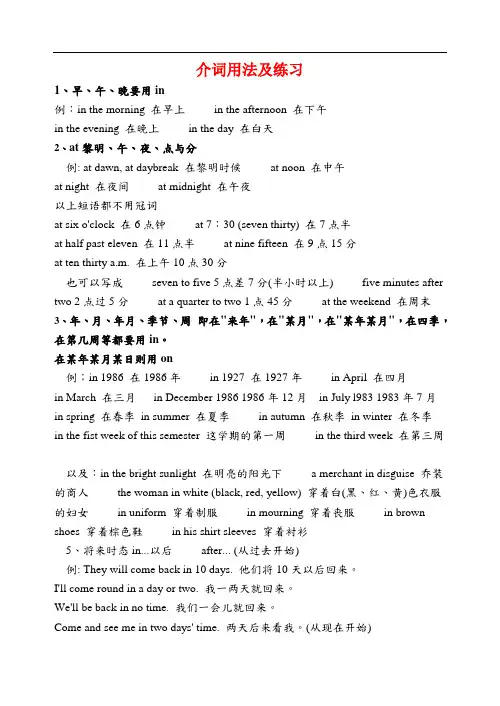
介词用法及练习1、早、午、晚要用in例:in the morning 在早上in the afternoon 在下午in the evening 在晚上in the day 在白天2、at黎明、午、夜、点与分例: at dawn, at daybreak 在黎明时候at noon 在中午at night 在夜间at midnight 在午夜以上短语都不用冠词at six o'clock 在6点钟at 7:30 (seven thirty) 在7点半at half past eleven 在11点半at nine fifteen 在9点15分at ten thirty a.m. 在上午10点30分也可以写成seven to five 5点差7分(半小时以上) five minutes after two 2点过5分at a quarter to two 1点45分at the weekend 在周末3、年、月、年月、季节、周即在"来年",在"某月",在"某年某月",在四季,在第几周等都要用in。
在某年某月某日则用on例;in 1986 在1986年in 1927 在1927年in April 在四月in March 在三月in December 1986 1986年12月in July l983 1983年7月in spring 在春季in summer 在夏季in autumn 在秋季in winter 在冬季in the fist week of this semester 这学期的第一周in the third week 在第三周以及:in the bright sunlight 在明亮的阳光下 a merchant in disguise 乔装的商人the woman in white (black, red, yellow) 穿着白(黑、红、黄)色衣服的妇女in uniform 穿着制服in mourning 穿着丧服in brown shoes 穿着棕色鞋in his shirt sleeves 穿着衬衫5、将来时态in...以后after... (从过去开始)例: They will come back in 10 days. 他们将10天以后回来。
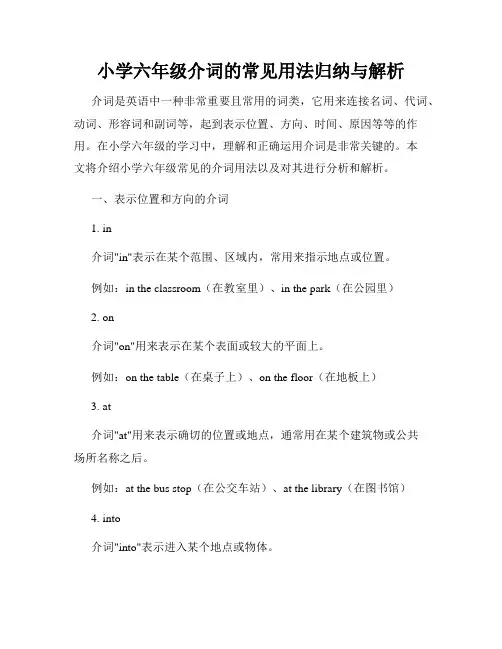
小学六年级介词的常见用法归纳与解析介词是英语中一种非常重要且常用的词类,它用来连接名词、代词、动词、形容词和副词等,起到表示位置、方向、时间、原因等等的作用。
在小学六年级的学习中,理解和正确运用介词是非常关键的。
本文将介绍小学六年级常见的介词用法以及对其进行分析和解析。
一、表示位置和方向的介词1. in介词"in"表示在某个范围、区域内,常用来指示地点或位置。
例如:in the classroom(在教室里)、in the park(在公园里)2. on介词"on"用来表示在某个表面或较大的平面上。
例如:on the table(在桌子上)、on the floor(在地板上)3. at介词"at"用来表示确切的位置或地点,通常用在某个建筑物或公共场所名称之后。
例如:at the bus stop(在公交车站)、at the library(在图书馆)4. into介词"into"表示进入某个地点或物体。
例如:jump into the water(跳进水中)、walk into the house(走进房子)5. out of介词"out of"表示从某个地方或物体出来。
例如:get out of the car(从车里出来)、take the book out of the bag (把书从包里拿出来)二、表示时间的介词1. at介词"at"用来指示具体的时间点。
例如:at 7 o'clock(在7点钟)、at noon(在中午)2. on介词"on"用来指示具体的日期或星期几。
例如:on Monday(在星期一)、on May 1st(在5月1日)3. in介词"in"用来指示一个时间段或某个月、季节、年代。
例如:in the morning(在早上)、in winter(在冬天)三、表示原因和目的的介词1. for介词"for"表示为了某个目的或原因。
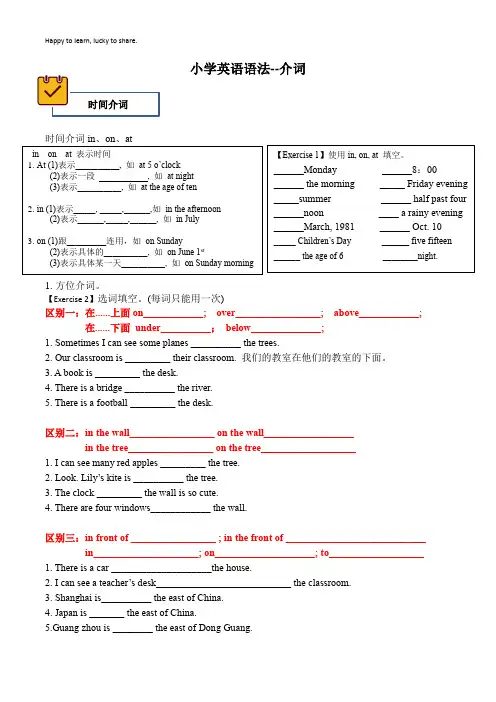
小学英语语法--介词时间介词in 、on 、at1. 方位介词。
【Exercise 2】选词填空。
(每词只能用一次)区别一:在......上面on____________; over_________________; above____________;在......下面 under__________; below______________;1. Sometimes I can see some planes __________ the trees.2. Our classroom is _________ their classroom. 我们的教室在他们的教室的下面。
3. A book is _________ the desk.4. There is a bridge __________ the river.5. There is a football _________ the desk.区别二:in the wall_________________ on the wall__________________in the tree_________________ on the tree___________________1. I can see many red apples _________ the tree.2. Look. Lily’s kite is __________ the tree.3. The clock _________ the wall is so cute.4. There are four windows____________ the wall.区别三:in front of _________________ ; in the front of ____________________________in_____________________; on____________________; to___________________1. There is a car ____________________the house.2. I can see a teacher’s desk___________________________ the classroom.3. Shanghai is__________ the east of China.4. Japan is _______ the east of China.5.Guang zhou is ________ the east of Dong Guang.in on at 表示时间 1. At (1)表示__________, 如 at 5 o’clock (2)表示一段 , 如 at night (3)表示__________, 如 at the age of ten2. in (1)表示_____, _____,______,如 in the afternoon (2)表示______,_____,______, 如 in July3. on (1)跟_________连用,如 on Sunday(2)表示具体的__________, 如 on June 1st(3)表示具体某一天__________, 如 on Sunday morning【Exercise 1】使用in, on, at 填空。
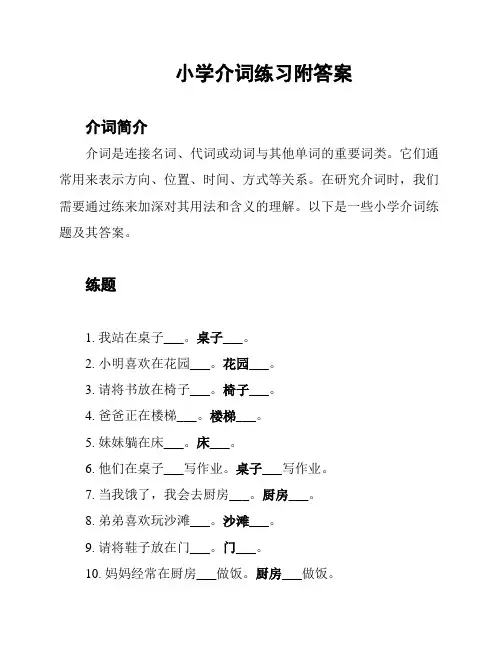
小学介词练习附答案介词简介介词是连接名词、代词或动词与其他单词的重要词类。
它们通常用来表示方向、位置、时间、方式等关系。
在研究介词时,我们需要通过练来加深对其用法和含义的理解。
以下是一些小学介词练题及其答案。
练题1. 我站在桌子___。
桌子___。
2. 小明喜欢在花园___。
花园___。
3. 请将书放在椅子___。
椅子___。
4. 爸爸正在楼梯___。
楼梯___。
5. 妹妹躺在床___。
床___。
6. 他们在桌子___写作业。
桌子___写作业。
7. 当我饿了,我会去厨房___。
厨房___。
8. 弟弟喜欢玩沙滩___。
沙滩___。
9. 请将鞋子放在门___。
门___。
10. 妈妈经常在厨房___做饭。
厨房___做饭。
答案1. 我站在桌子上。
桌子上。
2. 小明喜欢在花园里。
花园里。
3. 请将书放在椅子上。
椅子上。
4. 爸爸正在楼梯上。
楼梯上。
5. 妹妹躺在床上。
床上。
6. 他们在桌子上写作业。
桌子上写作业。
7. 当我饿了,我会去厨房里。
厨房里。
8. 弟弟喜欢玩沙滩上。
沙滩上。
9. 请将鞋子放在门上。
门上。
10. 妈妈经常在厨房里做饭。
厨房里做饭。
希望这些练习题和答案对你的学习有所帮助。
通过多做练习,你将更加熟练地运用介词,提高你的语言能力。
加油!。
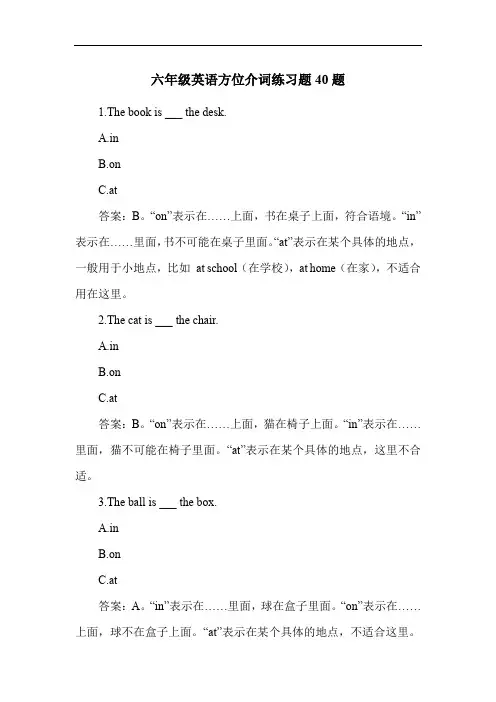
六年级英语方位介词练习题40题1.The book is ___ the desk.A.inB.onC.at答案:B。
“on”表示在……上面,书在桌子上面,符合语境。
“in”表示在……里面,书不可能在桌子里面。
“at”表示在某个具体的地点,一般用于小地点,比如at school(在学校),at home(在家),不适合用在这里。
2.The cat is ___ the chair.A.inB.onC.at答案:B。
“on”表示在……上面,猫在椅子上面。
“in”表示在……里面,猫不可能在椅子里面。
“at”表示在某个具体的地点,这里不合适。
3.The ball is ___ the box.A.inB.onC.at答案:A。
“in”表示在……里面,球在盒子里面。
“on”表示在……上面,球不在盒子上面。
“at”表示在某个具体的地点,不适合这里。
4.The picture is ___ the wall.A.inB.onC.at答案:B。
“on”表示在……上面,画在墙上。
“in”表示在……里面,画不可能在墙里面。
“at”表示在某个具体的地点,不合适。
5.The pen is ___ the book.A.inB.onC.at答案:B。
“on”表示在……上面,钢笔在书上面。
“in”表示在……里面,钢笔不在书里面。
“at”表示在某个具体的地点,不适合。
6.The clock is ___ the wall.A.inB.onC.at答案:B。
“on”表示在……上面,钟在墙上。
“in”表示在……里面,钟不可能在墙里面。
“at”表示在某个具体的地点,不合适。
7.The flower is ___ the vase.A.inB.onC.at答案:A。
“in”表示在……里面,花在花瓶里面。
“on”表示在……上面,花不在花瓶上面。
“at”表示在某个具体的地点,不适合。
8.The bird is ___ the tree.A.inB.onC.at答案:A。
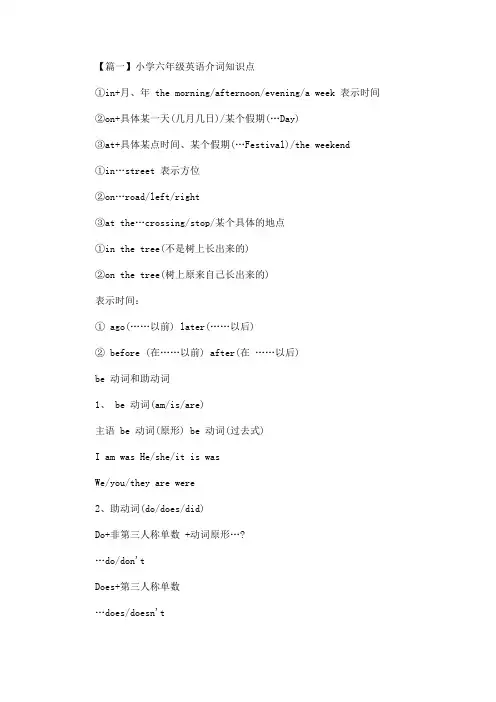
【篇一】小学六年级英语介词知识点①in+月、年 the morning/afternoon/evening/a week 表示时间②on+具体某一天(几月几日)/某个假期(…Day)③at+具体某点时间、某个假期(…Festival)/the weekend①in…street 表示方位②on…road/left/right③at the…crossing/stop/某个具体的地点①in the tree(不是树上长出来的)②on the tree(树上原来自己长出来的)表示时间:① ago(……以前) later(……以后)② before (在……以前) after(在……以后)be 动词和助动词1、 be 动词(am/is/are)主语 be 动词(原形) be 动词(过去式)I am was He/she/it is wasWe/you/they are were2、助动词(do/does/did)Do+非第三人称单数 +动词原形…?…do/do n'tDoes+第三人称单数…does/doesn'tDid+所有主格…did/didn'tWhat do you/they/we…+动词原形?I/They/We+动词原形…What does he/she/it…He/She/It +(动词+S)….What did you/they/we/ he/she/it…I/They/We/ He/She/It +动词过去式。
【篇二】小学六年级英语介词练习题1( ) 1. Why did you get up so early ___ this morning.A. onB. /C. atD. in( ) 2. He went to Shanghai___ September 3, 1991 and came back___ a cold morning last year.A. in; onB. on; inC. on; onD. in; ia( ) 3. Lucy was born____ the night of May 12, 1984.A. onB. inC. atD. to( ) 4. Mrs Brown came to China ____ 1996.A.onB. ofC. toD. in( ) 5 ___ the morning of November 20, 1915, the workers came to Chicago to show their mourning of Joe Hill.A. OnB. InC. OnD. At( ) 6. Ann moved___Hangzhou___September, 1992.A. /; inB. to; inC. to; on D, in; in( ) 7. They started off___an autumn afternoon.A. duringB. atC. inD. on( ) 8. He often goes ____ school ____ six thirty ____ the morning.A. for; to; inB. to; at; inC. to; for; at D, for; at; to( ) 9. He arrived ___ Shanghai ___ 9: 30 ___ March 5.A. at; in; atB. to; on; atC. in; on; atD. in; at; on( ) 10.The English teacher told me to get there____ half past ten.A. inB. atC. onD. of参考答案: B C A D B A D B D B【篇三】小学六年级英语介词练习题2( ) 1. Children get gifts ____ Christmas and ____ their birthdays.A. on; onB. at; onC. in; inD. in; on( ) 2.----There is nothing ____tomorrow afternoon, is there?-----No. We can have a game of table tennis.A. onB. inC. outD. up( ) 3. A lot of students in our school were born____March, 1981.A. inB. atC. onD. since( ) 4. He suddenly returned____ a rainy night.A. onB. atC. inD. during( ) 5. My grandfather was born____Oct. 10, 1935.A. onB. inC. atD. of( ) 6. The train is starting___five minutes.A. inB. atC. forD.still( ) 7. Mike does his exercises ____ seven _____ the evening.A. on; toB. at; inC. by; ofD. at; on( ) 8. Children wake up very early____the morning of Christmas Day.A. inB. onC. forD. at( ) 9 ____ a cold winter morning, I met her in the stfeet.A. InB. OnC. AtD. For( ) 10 It happened to be very cold____ the morning of our sports meeting.A. atB. onC. withD. of参考答案:B A A A A A B B B B。
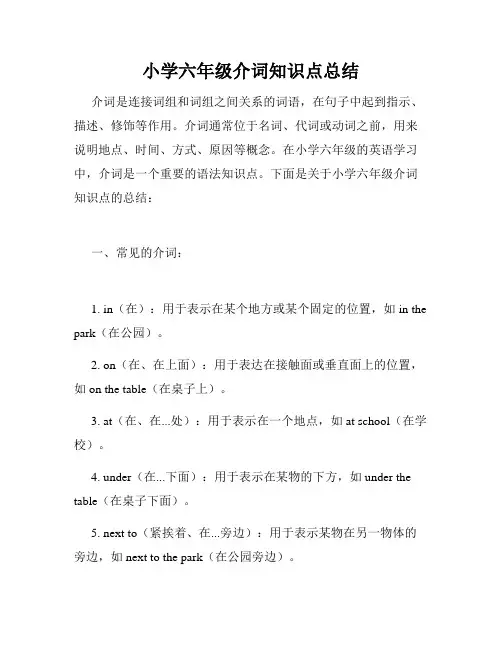
小学六年级介词知识点总结介词是连接词组和词组之间关系的词语,在句子中起到指示、描述、修饰等作用。
介词通常位于名词、代词或动词之前,用来说明地点、时间、方式、原因等概念。
在小学六年级的英语学习中,介词是一个重要的语法知识点。
下面是关于小学六年级介词知识点的总结:一、常见的介词:1. in(在):用于表示在某个地方或某个固定的位置,如in the park(在公园)。
2. on(在、在上面):用于表达在接触面或垂直面上的位置,如on the table(在桌子上)。
3. at(在、在...处):用于表示在一个地点,如at school(在学校)。
4. under(在...下面):用于表示在某物的下方,如under the table(在桌子下面)。
5. next to(紧挨着、在...旁边):用于表示某物在另一物体的旁边,如next to the park(在公园旁边)。
6. between(在...之间):用于表示两个物体之间的位置关系,如between the trees(在树木之间)。
7. behind(在...后面):用于表示某物在另一物体的后方,如behind the house(在房子后面)。
8. in front of(在...前面):用于表示某物在另一物体的前面,如in front of the car(在汽车前面)。
9. among(在...之中):用于表示在一群物体中的位置,如among the flowers(在花中间)。
10. with(与...一起):用于表示携带或陪伴关系,如go to the park with my friends(和我的朋友一起去公园)。
二、介词的使用规则:1. 表示地点:介词in用于大的地点,如国家、城市等;介词on用于具体的表面,如桌子、地图等;介词at用于具体的场所,如学校、商店等。
2. 表示时间:介词in用于年、季节;介词on用于具体的日期或星期;介词at用于具体的时刻。
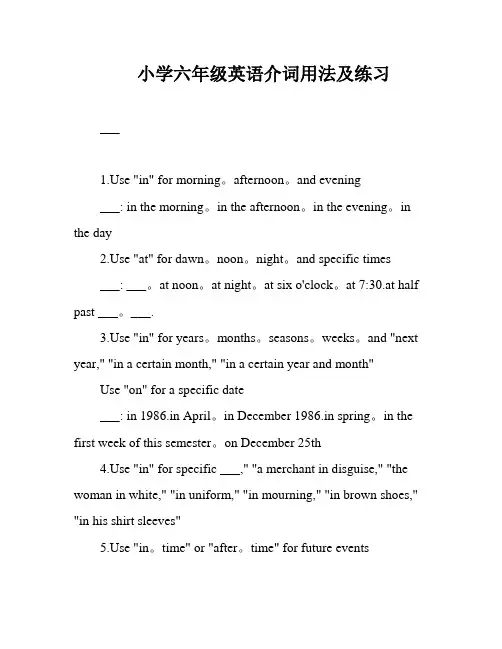
小学六年级英语介词用法及练习___e "in" for morning。
afternoon。
and evening___: in the morning。
in the afternoon。
in the evening。
in the daye "at" for dawn。
noon。
night。
and specific times___: ___。
at noon。
at night。
at six o'clock。
at 7:30.at half past ___。
___.e "in" for years。
months。
seasons。
weeks。
and "next year," "in a certain month," "in a certain year and month"Use "on" for a specific date___: in 1986.in April。
in December 1986.in spring。
in the first week of this semester。
on December 25the "in" for specific ___," "a merchant in disguise," "the woman in white," "in uniform," "in mourning," "in brown shoes," "in his shirt sleeves"e "in。
time" or "after。
time" for future events___: They will come back in 10 days。
新人教版小学六年级英语下册介词表一、关于介词的定义介词是一类虚词,用于表示人或物在时间、空间或逻辑关系上的位置、方向、时间等。
二、常用的英语介词1. in- 用于表示在某个时间段内,如in the morning(在早上)、in the afternoon(在下午)- 用于表示在某个季节,如in spring(在春季)、in summer (在夏季)- 用于表示在某个具体地点,如in the classroom(在教室)、in the park(在公园)2. on- 用于表示在某天或日期,如on Monday(在星期一)、on March 1st(在3月1日)- 用于表示在某个具体表面,如on the desk(在桌子上)、on the wall(在墙上)- 用于表示在某种交通工具上,如on the bus(在公交车上)、on the plane(在飞机上)3. at- 用于表示在某个具体时间,如at 3 o'clock(在3点钟)、at noon(在中午)- 用于表示在某个具体地点,如at school(在学校)、at the supermarket(在超市)- 用于表示在某种活动中,如at a party(在派对上)、at a concert(在音乐会上)4. into- 表示进入某个地方或状态,如go into the room(进入房间)、turn into a frog(变成一只青蛙)5. under- 表示在某物体下面或更低的位置,如under the table(在桌子下面)、under the bed(在床下)6. over- 表示在某个物体的上方,如over the bridge(在桥上)、over the clouds(在云上)7. through- 表示穿过某个地方或经过某个区域,如walk through the park (穿过公园)、drive through the tunnel(经过隧道)8. between- 表示在两个物体、位置或时间之间,如between the two trees (在两棵树之间)、between Monday and Wednesday(在星期一和星期三之间)9. among- 表示在三个或三个以上的物体、位置或时间之间,如among the flowers(在花中间)、among the students(在学生中间)10. behind- 表示在某个物体后面,如behind the door(在门后面)、behind the car(在车后面)11. in front of- 表示在某个物体前面,如in front of the house(在房子前面)、in front of the mirror(在镜子前面)12. next to- 表示在某个物体旁边,如next to the tree(在树旁边)、nextto the bookcase(在书架旁边)13. between- 表示在两个物体之间,如between the two houses(在两个房子之间)14. among- 表示在三个或三个以上的物体之间,如among the students(在学生之间)15. with- 表示伴随,如go to the park with my friend(和我的朋友一起去公园)16. without- 表示没有某物或某人,如eat lunch without vegetables(没有蔬菜的午餐)、go to the shop without money(没有钱去商店)17. for- 表示对某人或某物的利益或目的,如buy a gift for Mom(给妈妈买一份礼物)、study hard for the exam(为了考试而努力研究)三、使用介词的注意事项- 介词通常位于名词或代词之后,形成介词短语。
小学六年级英语地点介词单项选择题30道1. The cat is ____ the chair.A. inB. onC. atD. under答案:B。
本题考查地点介词的用法。
“on”表示在物体的表面上,猫在椅子上,所以用“on”。
“in”表示在物体内部,“at”通常表示在某个小地点,“under”表示在物体下方,均不符合题意。
2. My books are ____ the desk.A. inB. onC. atD. behind答案:B。
“on”用于描述物体在桌子的表面上,书在桌子上用“on”。
“in”指在内部,“at”指在小地点,“behind”指在后面,都不符合书在桌子上的情境。
3. The ball is ____ the box.A. inB. onC. atD. beside答案:A。
“in”表示在物体内部,球在盒子里用“in”。
“on”是在表面,“at”指小地点,“beside”指在旁边,均不符合球在盒子里的情况。
4. My sister is ____ home.A. inB. onC. atD. to答案:C。
“at home”是固定短语,表示在家。
“in”通常指在较大的空间内部,“on”用于表面,“to”表示方向,都不符合在家的表达。
5. The pictures are ____ the wall.A. inB. onC. atD. under答案:B。
“on the wall”表示在墙上,图片在墙上用“on”。
“in”指在内部,“at”指在小地点,“under”指在下方,均不符合图片在墙上的意思。
6. Tom is playing ______ the playground.A. inB. onC. atD. to答案:A。
本题考查地点介词的用法。
“in the playground”表示“在操场上”,是固定搭配。
选项B“on”通常用于表面,比如“on the table”;选项C“at”用于较小的地点,比如“at the bus stop”;选项D“to”表示方向,不符合此处语境。
六年级毕业考试英语语法之介词【导语】语法的提高不是靠做题得来的,而是依靠平时大量使用:写作和口头表达,当规则成为我们的习惯时,这些知识才真正是我们的。
作者准备了以下内容,供大家参考。
1.Ina.In用于室内或室外的场所。
in a room / in a building在房间/大楼里in a garden / in a park在花园/公园里I have two TVs in my house.我房子里有两个电视。
They live in that building over there.他们住在那栋楼里。
b.in与水域进行搭配in the water在水里in the sea在海里in a river在河里I like swimming in lakes when the weather is hot.我爱好天气热时在湖里游泳。
You can catch fish in the river.你可以在湖里捉鱼。
c.in和行、队伍等进行搭配in a row / in a line一行in a queue一队Let's stand in line and get a ticket to the concert.站成一行,买票去听音乐会。
We had to wait in a queue to get into the bank.我们只得站成一队等着进入公园。
d. in与城市、县、州、地区和国家搭配Peter lives in Chicago.皮特住在芝加哥。
Helen is in France this month. Next month she'll be in Germany.海伦这个月在法国。
下个月她就在德国了。
2.Ata.at与具体的地点进行搭配at the bus-stop在公交车站at the door在门边at the cinema在电*at the end of the street在街的尽头I'll meet you at the movie theater at six o'clock.我六点在电*见你。
小学六年级英语语法:介词短语的运用什么叫做介词短语
介词 + 名词(或者代词,或者相当于名词的其他词类、短语、从句)= 介词短语
in the morning 在早晨
under the tree 在树下
from China 来自中国
*注意区别“介词短语”和“短语介词”:
介词短语是(介词 + 名词性短语),能够单独作为句子成分;
短语介词是(一个相当于介词的短语),不能单独作为句子成分。
短语介词:
according to 根据
ahead of 在……之前
apart from 在……之外
because of 因为
by means of 以……之手段
by way of 作为
介词短语的位置
一、位于动词之后表示位置
She lives in Shanghai.
她住在上海。
The children are playing in the street now.现在孩子们在街上玩。
二、位于动词之后表示方向
He went into the kitchen.
他到厨房里去。
三、位于句首表示突出、对照
In the garden everything was so beautiful.花园里一切都是那么美丽。
四、位于句首,倒装主谓
Behind me lay the fields.
在我的后面是一片田野。
On the desk is a bag.
桌子上有一个袋子。
五、位于名词之后,用于限制前面的名词
The apple on the plate is for you.
盘子上的苹果是给你的。
小学六年级英语语法介词for的用法小学六年级英语语法介词for的用法介词 for 的用法小结1. 表示“当作、作为”。
如:I like some bread and milk for breakfast. 我喜欢把面包和牛奶作为早餐。
What will we have for supper? 我们晚餐吃什么?2. 表示理由或原因,意为“因为、由于”。
如:Thank you for helping me with my English. 谢谢你帮我学习英语。
Thank you for your last letter. 谢谢你上次的来信。
Thank you for teaching us so well. 感谢你如此尽心地教我们。
3. 表示动作的对象或接受者,意为“给……”、“对…… (而言)”。
如:Let me pick it up for you. 让我为你捡起来。
Watching TV too much is bad for your health. 看电视太多有害于你的健康。
4. 表示时间、距离,意为“计、达”。
如:I usually do the running for an hour in the morning. 我早晨通常跑步一小时。
We will stay there for two days. 我们将在那里逗留两天。
5. 表示去向、目的,意为“向、往、取、买”等。
如:Let’s go for a walk. 我们出去散步吧。
I came here for my schoolbag.我来这儿取书包。
I paid twenty yuan for the dictionary. 我花了20元买这本词典。
6. 表示所属关系或用途,意为“为、适于……的”。
如:It’s time for school. 到上学的.时间了。
Here is a letter for you. 这儿有你的一封信。